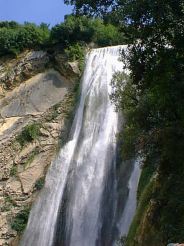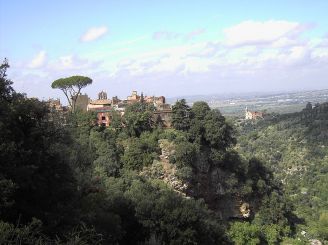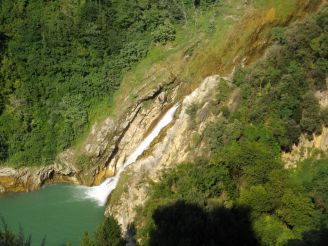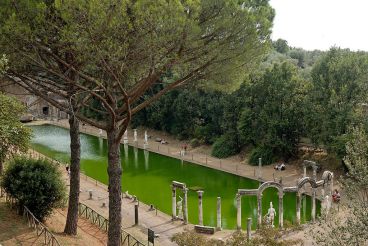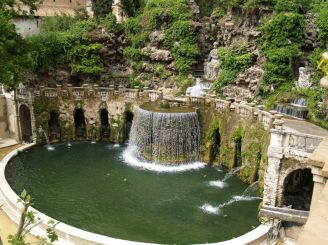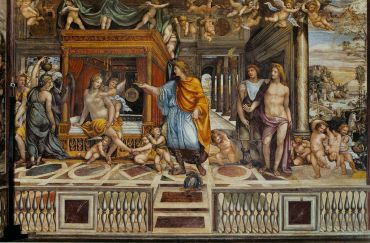Villa Gregoriana, Tivoli

Villa Gregoriana in Tivoli is not really what you expect it to be after hearing the name for the first time. This is not a construction, but an artificially altered nature park. It is considered to be a great example of the perfect collaboration between human and nature – you can notice it in waterfalls, grottos, breaks, temples, catacombs, tunnels and steep paths disappearing in lush. An impressive man-made 120-meter long waterfall - the second largest waterfall in Italy after the Cascata delle Marmore – is the highlight and main sight in the park.
Park’s history
Its history begins tragically. A small town that once lied across the Aniene’s shore, the current location of Tivoli, used to suffer from floodings every year. In 1826 an especially severe natural disaster occurred and not only destroyed a large number of buildings, but also claimed human lives. Then the pope ordered to start the construction of waterworks.
In 1832 Clemente Folchi was put in charge of the project. The river stream was channeled into two tunnels dug through Mount Catillo. This resulted in the formation of the famous Grand Cascade and numerous minor waterfalls. Everything was completed in 1835; then later the pope decided to expand the area and set up a park there. Benches, narrow paths, observation decks and eventually signposts started appearing here and there among the rocks and waterfalls. This place slowly became recognized by many painters and writers who visited and praised it in their artworks.
After the World War II Villa Gregoriana came into state ownership. However, the Italian government failed to maintain the landmark even though such thing happens very rarely.
In 2002 the complex was leased to Italian Heritage Trust (FAI) in an awfully poor condition. And then in 2005 the park was opened to the public and looked as if it returned to life once again.
Sights to see at Villa Gregoriana
To fully appreciate all the park’s beautiful sceneries you should consider putting on comfortable footwear. You’ll have to deal with a lot of stairways and bumpy paths. Flora will surprise you with its variety – there are 74 types of trees and even more kinds of flowers whose fragrances will take your breath away.
- Cascata di Tivoli waterfall. After power plant was built upstream, it became less deep but retained its beauty.
- The Neptune’s Cave and the Cave of the Sirens.
- The Miollis Path. It is a small tunnel with windows bored through a rock in 1809 by order of the Roman governor, French general Miollis.
- Ruins of the villa once owned by Roman consul Manlio Vopisco. This is a must-see sight for those who like antiquities. In its heyday, this consul’s property was so fascinating that Roman poet Horace praised it in his odes.
- The Temple of Vesta. It was discovered in the 1st century BC. It looks well-preserved since at one point the building was turned into a church. However, in the 16th century, the temple restored its original look after Christian constructions almost entirely disappeared. This shrine stands on a round foundation and is surrounded by the Corinthian columns, today you can see only 10 of them instead of all 18.
How to get
Villa Gregoriana is located in Tivoli, on Largo Sant'Angelo, 35 km east of Rome. The Villa d'Este and Rocca Pia Castle situated around here also welcome visitors.
- The most convenient way to reach the park is by train. You’ll need to get on it at the Roma Tiburtina station and take it to the Tivoli station. The ride usually lasts for 50 minutes.
- You can also take a bus. Catch the Cotral bus that stops every 15 minutes at the Ponte Mammolo subway station in Rome. It will take 50 minutes to get to the place.
- If you travel by car, follow Via Tiburtina and then SR5.
Opening hours: depend on the season.
- March: from Tuesday to Sunday from 10:00 till 16:00.
- April – September: daily from 10:00 till 18:00.
- October: from 1 to 15 October 10:00 - 18:30; from 16 to 22 October 10:00 - 18:00; from 22 to 31 October 10:00 - 16:00.
- 1 November – 17 December: from Tuesday to Sunday from 10:00 till 18:00.
Admission: the ticket costs 8 Euros for adults and 4 Euros for children. The information is relevant for January 2018.



